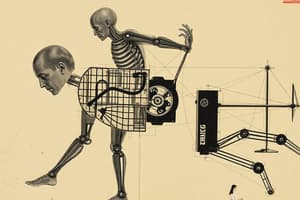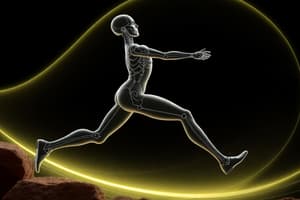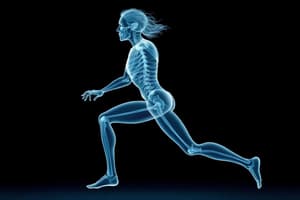Podcast
Questions and Answers
What does Newton's first law, the law of inertia, state about a body at rest or in constant linear velocity?
What does Newton's first law, the law of inertia, state about a body at rest or in constant linear velocity?
- It requires a net force to maintain its state of motion.
- It remains in its state unless acted upon by an external force. (correct)
- It can change direction without an external force.
- It will accelerate if no net force is applied.
What is the difference between static and dynamic equilibrium according to Newton's first law?
What is the difference between static and dynamic equilibrium according to Newton's first law?
- Dynamic equilibrium can only occur with changing velocity.
- Static equilibrium occurs only with external forces.
- Static equilibrium has zero velocity, while dynamic equilibrium has constant velocity. (correct)
- Dynamic equilibrium is only possible with acceleration.
What term is used to describe rotary motion in relation to Newton's first law?
What term is used to describe rotary motion in relation to Newton's first law?
- Torque (correct)
- Inertia
- Force
- Momentum
Which of the following best defines the term 'inertia' in the context of Newton's laws?
Which of the following best defines the term 'inertia' in the context of Newton's laws?
Which aspect of motion is not addressed by Newton's first law?
Which aspect of motion is not addressed by Newton's first law?
What determines the mass moment of inertia of an object?
What determines the mass moment of inertia of an object?
Where is the center of mass located in the human body?
Where is the center of mass located in the human body?
What happens to the center of mass of an individual body segment during movement?
What happens to the center of mass of an individual body segment during movement?
What is the effect of decreasing mass moment of inertia on angular velocity?
What is the effect of decreasing mass moment of inertia on angular velocity?
What is one way to reduce mass moment of inertia when swinging a baseball bat?
What is one way to reduce mass moment of inertia when swinging a baseball bat?
Which of the following describes the effect of mass on angular velocity?
Which of the following describes the effect of mass on angular velocity?
What would happen to a diver's angular velocity if they spread their arms and legs out during a dive?
What would happen to a diver's angular velocity if they spread their arms and legs out during a dive?
What characteristic does inertia exhibit in relation to mass?
What characteristic does inertia exhibit in relation to mass?
What happens to the center of mass of the entire lower extremity when a person lifts their leg?
What happens to the center of mass of the entire lower extremity when a person lifts their leg?
Flashcards are hidden until you start studying
Study Notes
Newton's Laws of Motion
- Newton's three laws of motion form the foundation of biomechanics.
- Developed in 1687, these laws explain motion in the human body.
Newton's First Law: Law of Inertia
- A body at rest stays at rest, or in constant linear velocity, unless acted upon by an external force.
- A force is needed to start, stop, or change linear motion; torque is the equivalent for rotary motion.
- Equilibrium: Static (velocity = 0) and Dynamic (constant velocity, acceleration = 0).
- Inertia: A property of matter resisting changes in its state of rest or motion; directly proportional to mass.
- Center of Mass (COM) or Center of Gravity (COG): The point where mass is evenly distributed, gravity acts. Located just anterior to the sacrum in the human body (colloquially, the belly button).
- The COM of a body segment remains constant during movement; the COM of an entire limb changes with movement.
- Mass Moment of Inertia (MMOI): A body's resistance to changes in angular velocity; depends on mass and mass distribution around the axis of rotation. Decreasing MMOI increases angular velocity (inverse relationship).
Altering Mass Moment of Inertia
- Reducing MMOI increases angular velocity. This can be achieved by:
- Decreasing mass (e.g., lighter running shoes for faster sprinting).
- Changing mass distribution (e.g., "choking up" on a baseball bat to reduce its effective length, resulting in faster swing speed).
- Changing body position (e.g., a diver tucking their limbs to rotate faster).
Newton's Second Law: Law of Acceleration
- A body's acceleration is directly proportional to the net force and inversely proportional to its mass (F = ma).
- Force is measured in Newtons (kg⋅m/s²).
- Applied to rotary motion: Torque (force × moment arm) equals mass moment of inertia × angular acceleration.
- Moment arm: Distance between the axis of rotation and the point of force application.
- Torque and moment of force are interchangeable terms
- Angular acceleration is inversely proportional to MMOI.
Newton's Third Law: Law of Action-Reaction
- For every action, there's an equal and opposite reaction.
- Example: A person's weight exerts force on the ground, and the ground exerts an equal and opposite ground reaction force on the person.
- Example 1: A broken toe caused by a fall; the foot's force on the ground is met with an equal force from the ground, resulting in fracture.
Studying That Suits You
Use AI to generate personalized quizzes and flashcards to suit your learning preferences.




